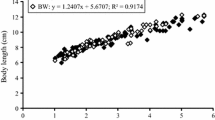Summary
The freshwater fish,Cirrhina reba, is acclimated to different salinities up to 50% sea-water and found to be stenohaline. Survival in 50% seawater is only 12 hours.
Both tissue fluid chloride and blood choride increase with the increase of salinity of the medium.
In 40% sea-water blood chloride shows an increase of 14% over the freshwater fish while tissue fluid chloride increases by 83%. But in 50% sea-water, which is lethal, blood chloride increases sharply while tissue fluid chloride is nearly double that in freshwater.
Fish kept in distilled water for one day show a 17% decrease in blood chloride while chloride in tissue fluid remains unaltered.
The results are discussed and it is suggested that part of the regulation consists in shifting some of the blood chloride to the tissue fluids. In 50% sea-water failure seems to be in the inability of the fish to pump out the excess chloride as fast as it enters.
Acclimation to high temperature results in a slight decrease in chloride in the blood and tissue fluids.
Similar content being viewed by others
References
Breder, C. M., Jr... “Ecology of an oceanic freshwater lake, Andros island, Bahamas, with special reference to its fishes,”Zoologica, 1934,18, 57–88.
Copeland, D. E... “The cytology of secretory cells ofFundulus,”J. Morph., 1948,82, 201–28.
Getman, H. C... “Adaptive changes in the chloride cells ofAnguilla rostrata,”Biol. Bull., 1950,99, 439–51.
Gilbert, A. B... “The composition of the blood of the shore crab,Carcinus moenas Pennant, in relation to sex and body size. II. Blood chloride and sulphate,”J. Exp. Biol., 1959,36, 356–63.
Grafflin, A. L... “The problem of adaptation to freshwater and sea-water in the teleosts,”J. cell. comp. physiol., 1937,9, 469–76.
Padmanabhanaidu, B. and Ramamurthy, R. “The influence of sex and size on the osmotic pressure, the chloride and the free amino-acids of the blood of the F.W. field crabParatelphusa and the F.W. Mussel,Lamellidens marginalis,”J. Exp. Biol., 1960,38, 35–41.
Pampapathi Rao, K... “Salinity tolerance ofEtroplus maculatus (Block),”Curr. Sci., 1958,27, 99.
—— and Ramachandra, R. “Effect of acclimatization to high temperature on the blood chloride, free amino-acids, and osmotic pressure in the freshwater field crabParatelphusa sp. and the freshwater musselLamellidens marginalis,”J. Exp. Biol., 1961,38, 29–34.
Robertson, J. D. and Webb, D. A. “The micro-estimation of sodium, potassium, calcium, magnesium, chloride and sulphate, in sea-water and body fluids of marine animals,” Ibid., 1939,16, 155–77.
Author information
Authors and Affiliations
Additional information
Communicated by Dr. H. Srinivasa Rao,f.a.sc.
Rights and permissions
About this article
Cite this article
Selvarajan, V.R. Chloride regulation in a freshwater fish,Cirrhina reba, under heterosmotic conditions and high temperature. Proc. Indian Acad. Sci. 55, 91–98 (1962). https://doi.org/10.1007/BF03051870
Received:
Issue Date:
DOI: https://doi.org/10.1007/BF03051870



